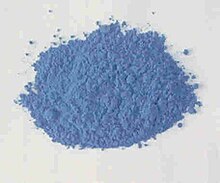
Back أزرق مصري Arabic ازرق مصرى ARZ Egyptská modř Czech Ägyptisch Blau German Egipta bluo Esperanto Azul egipcio Spanish Egiptuse sinine Estonian Bleu égyptien French כחול מצרי HE Egipatska plava Croatian
| Egyptian blue | |
|---|---|
 | |
| Hex triplet | #1034A6 |
| sRGBB (r, g, b) | (16, 52, 166) |
| HSV (h, s, v) | (226°, 90%, 65%) |
| CIELChuv (L, C, h) | (28, 82, 263°) |
| Source | [Unsourced] |
| ISCC–NBS descriptor | Vivid blue |
| B: Normalized to [0–255] (byte) | |
Egyptian blue, also known as calcium copper silicate (CaCuSi4O10 or CaOCuO(SiO2)4 (calcium copper tetrasilicate)) or cuprorivaite,[1] is a pigment that was used in ancient Egypt for thousands of years. It is considered to be the first synthetic pigment.[2] It was known to the Romans by the name caeruleum. After the Roman era, Egyptian blue fell from use and, thereafter, the manner of its creation was forgotten. In modern times, scientists have been able to analyze its chemistry and reconstruct how to make it.
The ancient Egyptian word wꜣḏ signifies blue, blue-green, and green.
The first recorded use of "Egyptian blue" as a color name in English was in 1809.[3]
- ^ Cuprorivaite, mindat.org
- ^ Eastaugh, Nicholas; Walsh, Valentine; Chaplin, Tracey; Siddall, Ruth (2004). "Egyptian blue". The pigment compendium: Optical microscopy of historical pigments. Oxford, UK: Elsevier Butterworth Heinemann. pp. 147–148.
- ^ Maerz and Paul A Dictionary of Color New York:1930 McGraw-Hill Page 194; Color Sample of Sunset: Page 93 Plate 35 Color Sample L8
© MMXXIII Rich X Search. We shall prevail. All rights reserved. Rich X Search